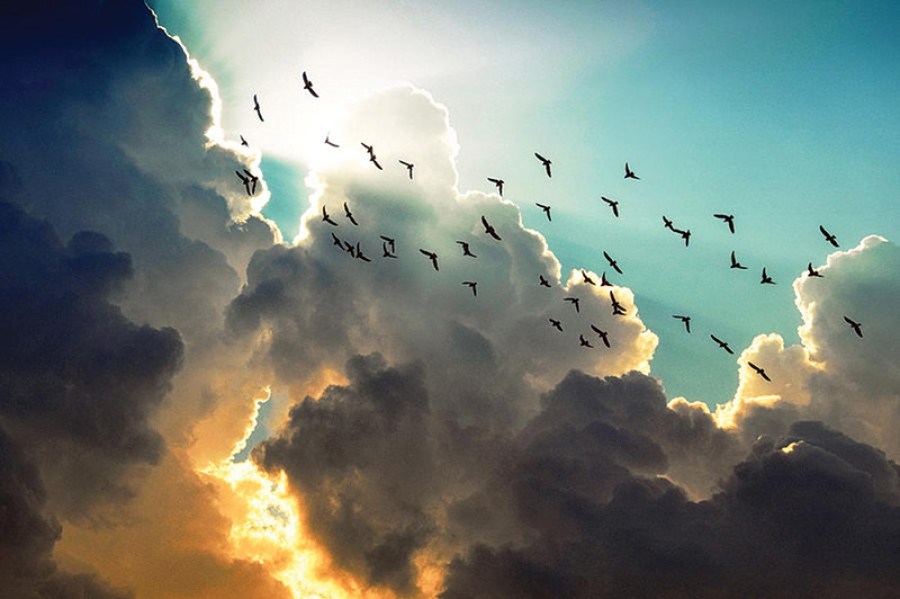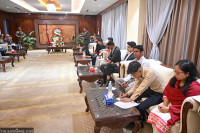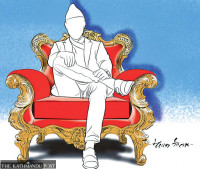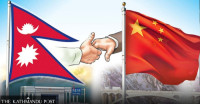Opinion
Geopolitical romanticism
Nepal should see both India and China from a creative, geo-cultural perspective where hostility is given no place
A photograph of the chairman of the CPN-UML, KP Sharma Oli whose party has attained a sweeping victory in the recent elections, showing the precipice and pass of Rasuwagadhi to his spellbound comrades struck me. He was showing the future path of a Chinese railway line that would come whistling down the alpine altitude to Kathmandu Valley, Janakpur and India, opening tremendous possibilities of progress and prosperity for Nepal. Rasuwagadhi looks like it has been ravaged by the earthquake of 2015. Below that Himalayan valley, many earthquake victims still face extreme weather without proper roofs over their heads, unseen by all the great leaders of the parties and governments in Nepal whose amnesia is the cause of the suffering that the common people have to endure. To see rocks on either side of the border was the metaphorical imagination of King Prithvi Narayan Shah, the unifier of this land. The difference between the two is that PN Shah’s imagination was spatio-political, whereas Oli’s imagination is fluid and ambitious. However, the basis of both men’s imaginations is strategic and existential.
Establishing links
The title ‘geopolitical romanticism’ makes it clear that this take is not about political imagination, nor is it directly related to literary romanticism that has long dominated the Nepali, Newari and Maithili literary discourses of this country. But a certain connectivity can be established by alluding to the works of the writers and painters of Nepal and its two neighbours. I would like to present my argument by contextualising a few references. I am citing mainly those references that relate to the geo-cultural imagination of a Nepali poet and a Chinese painter. The poet is Laxmi Prasad Devkota who has described the Bharatabarsha or the South Asian region in his geo-cultural imagination. In his great epic Shakuntala, famously known to be penned by the poet in three months and celebrated by the Nepali critics as the masterpiece of Nepali romantic poetry, Devkota describes the South Asian geo-cultural space and the imagination in a verse that begins with ‘Hamra bharata barsaka vijayako’, in which he valorises the victory of Bharata Varsha of the golden age. The poet’s nostalgia and hope that those golden times will return one day is very strong and can be likened to how a lady cuckoo bird sits even on a wintry bough weeping and remembering the smell of the summer buds. The South Asian cultural imagination tinged with romanticism has become an element in philosophical thinking, poetry, politics, films and art from very early times. A study of spaces, culture and the literary hubs of South Asia that lie in today’s India and Pakistan speak volumes about this romanticism which is not so comprehensively studied under this very rubric. In Nepali literature and art, this element of romanticism is a dominant factor. Politicians and anthropologists too evoke romanticism in their respective fields. Politicians, whose textual outputs badly lack the visceral element, evoke romanticism nonetheless by establishing a link to either religion or some kind of geographical bonding. We in the folklore studies harp on about the romance, romanticism and visceral aspect of tradition.
Epic imagination
China also comes to the Nepali romantic imagination, especially on two scores. First it comes in traditional Nepali art, which is strongly linked to the visit of the 13th century Nepali artist Araniko, whose masterpiece, a white Caitya built in the heart of Beijing eloquently combines history and art. I was a little surprised to see the mementos created and left behind by visiting important Nepalis around the structure, because these props and figurines lack romantic elements and are quite crude in their projection of Nepali identity. To me they looked bland. But the Caitya itself evokes the romantic imagination. It is a great work of architectural art. Araniko’s other works in Tibet are also cited for that purpose. Arniko’s history has inspired the centenarian cultural scholar and dramatist Satyamohan Joshi alias Satyamohandai to write an epic, which, unlike Devkota’s Shakuntala, is constructed around history. I only want to repeat the gist of what I have already written in Kantipur about the Sino-Nepali epic imaginaire. Joshi has created an epic out of themes that do not resonate with the ancient poetic myths. The only bases of epic imagination linked with China are princess Bhrikuti, artist Araniko, Buddha and the related art and aesthetics. The epic details the life and narrative of creativity forgotten by the Nepalis, and a certain bright page of history that is lost in memory. Arniko is probably the last epic hero of the Sino-Nepali imagination whose loftiness and simplicity constitute that quality. Will any epic stories be written on any Sino-Nepali motifs? The answer is not clear. But a certain artistic vision still works.
Secondly, I should mention the exhibition of paintings by an internationally famous Chinese painter Zhao Jianqiu in Kathmandu to mark the 60th anniversary of Nepal- China relations. I wrote an introduction to a book of his paintings titled Celebrating the trans-Himalayan bond made available at his exhibition in Kathmandu, and a review in The Kathmandu Post in which I have mentioned the exhibition and the timing of his art when Nepal was “grappling with crises that are political, emotional and economic in nature” (October 18, 2015). The image published for my article in The Kathmandu Post is a painting he executed to show the Nepal-China bond. It shows a path going up to the Himalayan valley over to the Tibetan region of China. That is beautifully romantic in nature, which speaks more than a politician’s somewhat unrealistically hasty evocation. I would want to evoke the poetic imagination of the artist, which is more meaningful than any political bravado. Nepal and China are bonded by artistic and poetic imagination. Zhao also made paintings on the theme of the 5th century Chinese ambassador Wang Huen Che’s description of Kailashakut Bhavana in Handigaon during the Lichhavi period, and many more cultural anthropomorphic themes, all poetic, artistic and romantic in creative sense.
My conviction is that Nepal should see both India and China from a creative perspective as mentioned in this article. Hostility should have no place in the creative geo-cultural romanticism.




 18.12°C Kathmandu
18.12°C Kathmandu









